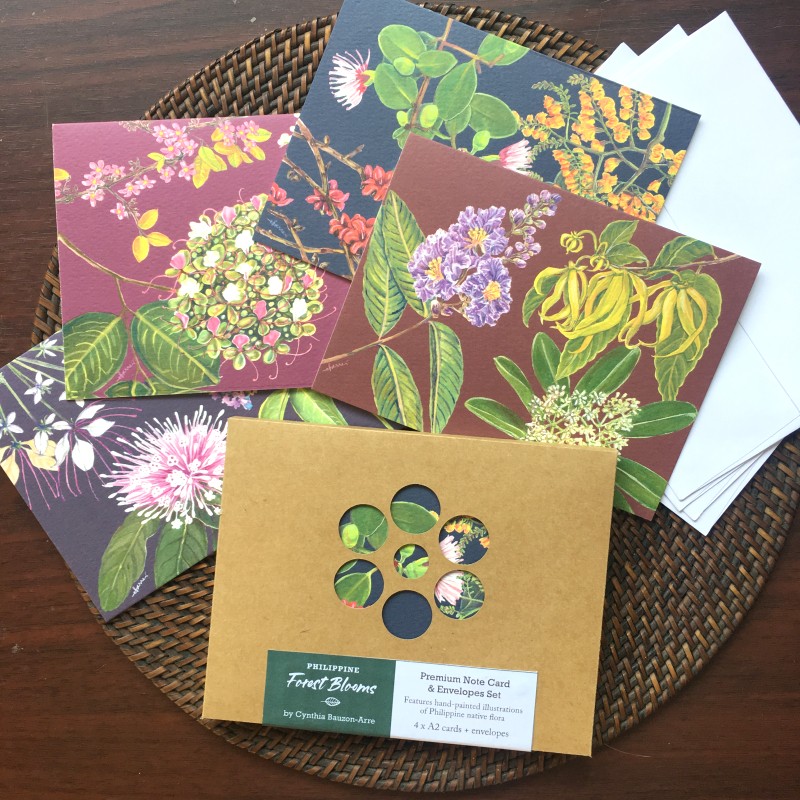MANILA, PHILIPPINES — The Philippines is home to a plethora of flora, including lovely native flowering trees that can even match up to others from all around the world, something most Filipinos are not exactly actively aware of. As the years go by, the numbers of these native trees in Philippine forests have dwindled, raising a more pressing need to protect and conserve them.
That being said, we caught up with illustrator and graphic designer Cynthia Arre and talked to her about the beautiful illustrations she has created depicting our native flora and fauna. What started out as a personal art project that she shared on social media and on stationery items to sell, has caught the attention of Forest Foundation Philippines, and from it a partnership that would bring this important subject even closer to the light.
The project, through its stunning and detailed illustrations, has also reached a younger audience and encouraged even more artists to delve into the rich world of the country’s native trees with the hashtags #ForestBloomsPH and #DrawNativeTreesPH.
Cynthia shared with us the whole story behind the campaign: how she first got interested in native trees, how the FFP came into contact with her, the design process she went through to ensure the illustrations’ accuracy, design softwares she used, and more.
Read her full interview below:
Can you share what the native trees campaign is all about?
The campaign I am working on with Forest Foundation Philippines (FFP) is all about raising awareness on the important role of Philippine native trees in forest conservation through art. In the last few decades, there has been a steady decline in the Philippine forests so FFP has an ongoing campaign called Best Friends of the Forest wherein they have tapped advocates from other fields, such as mountaineering, education, science, etc. Art is one of the passion points they have chosen to promote it through, and as an illustrator / graphic designer, that’s where I come in.
How did this partnership with Forest Foundation Philippines come about?
It started with me becoming nostalgic for my childhood, which led me to recalling local fruits and common Philippine flowers that grew in my family’s home. I then made drawings of these and designed stationery items to sell. When I posted them on social media, I learned that some of the younger generation do not recognize these fruits and flowers, and that made me want to create products that can somehow help bring them back to the fore.
The project got me interested about indigenous species. I learned that we have a ton of beautiful, and, sadly, critically endangered native flora and fauna, so I drew and posted about them on Instagram. That small personal campaign, as well as the stationery I mentioned earlier, drew the attention of Forest Foundation Philippines, a nonprofit that provides grants that empower organizations and people to protect the forests. This was in early 2018. FFP invited me to collaborate with them and so, with their backing, as well as the guidance of their foresters, scientists, and project managers, I’ve been developing products and holding art activities that help raise awareness for the protection and conservation of Philippine native trees.
Why the interest in native trees? And how did you go about figuring out how to illustrate them?
Many people like going abroad to see flowering trees, like the sakura in Japan, but not too many people know that we have our own flowering trees that are just as striking, if not even more beautiful. Aside from the aesthetic factor, planting native trees is important because they adapt better to our environment hence their resilience to extreme weather conditions. Native trees also conserve an area’s biodiversity by forming intricate networks with birds, insects and other species by providing them homes.

Doing the illustrations was challenging at first because I wasn’t used to drawing flora in an accurate way. My first drawings had errors because I wasn’t paying close attention to, for example, the shapes of the leaves and even their veins. This is FFP’s foresters’ area of expertise so thanks to their keen eyes, I was able to correct the mistakes, and the experience also taught me to be more mindful of what I’m drawing.
How big of a role did research play into your designs, specifically for this project?
Some of the reference photos were provided to me by FFP’s foresters by way of books and digital photos. They also invited me to attend a seminar on taxonomy last year which was of great help in honing the way I draw flora these days, because now I know to look at each species’ unique qualities, from the variations in petal and leaf shapes, to infloresecence and branch growth patterns.
Can you walk us through your design process?
1. Research — This is where I work closely with FFP. They guide me in identifying which species to draw, and in gathering photos and information about them (conservation status, areas where they grow, and what the trees are known and used for).
2. Illustration — Using a variety of reference photos, I proceed with drawing the elements of the tree in a way where one can possibly identify them in the wild. For the previous projects we did, I used a combination of gouache and watercolor to draw the elements.
3. Feedback — When the illustrations are done, I take photos and submit them to FFP for comments.
4. Design and Layout — Once the illustrations are approved, I scan them and work on the design and layout of the item we are making. The first project we did together was an undated planner called Philippine Forest Blooms. For this project, I used a combination of Adobe Photoshop and InDesign (though for succeeding works, I have been using Affinity Photo, Publisher, and Designer).
5. Feedback / Review — Once the initial layouts are done, I submit them again for FFP’s feedback. Design-wise, they generously give me free reign, so it’s really more about reviewing the text to check facts and consistency.
6. Printing — After everything is approved, I export press-ready files, zip them up in a folder, and email that to the printing press.
How important is it to shine light on this in such a creative way?
Among our goals is to make information about our native trees easily accessible to the public and we have done this by designing products that can be used in daily life — the planner, a desk calendar, stationery such as greeting cards and notebooks, and tote bags. The initial products we made feature some of the Philippines’ native flowering trees. I sell them in my online shop and in stores I consign with, while FFP gives them away for free during their events and conferences. This year, we are coming out with Philippine Forest Fruits, a boxed set of 30 postcards featuring Philippine native fruits. We have also held watercolor workshops and are planning to hold some more outside Metro Manila sometime in the future.
Audience response
On social media, we encourage people to take photos of native trees, upload them, and post captions with the hashtag #ForestBloomsPh. We also encourage artists to use the hashtag #DrawNativeTreesPh when they draw native species. So far, the response has been good and interest in our indigenous rees and plants seems to have increased. Our Philippine Forest Blooms planner got sold out just a few days after announcing its availability online, and the first watercolor workshop we staged had a good turnout of participants.
Social media links
Website: https://cynthiabauzonarre.com/
Instagram: https://www.instagram.com/arncyn
Facebook: https://www.facebook.com/cynthiabauzonarre
Photos from Cynthia Arre














